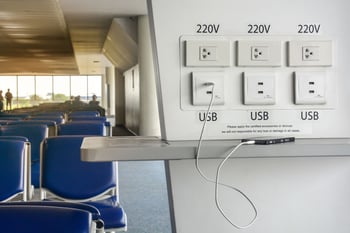As a small business, you may not be at the forefront of developing technology as much as an enterprise-level business, but technology still plays a vital role in the growth and efficiency of your organization. Given how much things have changed last year, small business technology trends are sure to be important in 2021.
The typical small business doesn't have an inhouse IT department, let alone have the resources or acumen to deploy third party platform technologies like AI. So, how do you stay competitive? From a strategic perspective, something to keep in mind is IT spending as a percentage of revenue is now landing somewhere around 8 percent for most professional service firms, while coming in much lower in manufacturing or distribution companies (ie: closer to around 4 percent).
That said, we've put together what we're seeing as some of the biggest technology-related changes for small businesses for the year. Here are 10 small business technology trends to watch for in 2021...
1. Remote Work
Of course we're all pretty aware of how impactful the pandemic was in "helping" businesses to accept a more robust work from home approach. Prior to 2020, WFH accounted for less than 20% of most businesses staffing footprint. After the pandemic, it's now been flipped to almost 80%. And while the vaccines are helping to hold the pandemic at bay and "get back to normal", there's no hiding the fact that we're not going back but rather forward into the "new normal." And this means a greater remote work force than ever before. Even allowing for more of a hybrid or "hoteling" approach, numbers don't lie - we've seen the future and remote work is here to stay.
2. Remote Onboarding
Optimistically, we’re still months away from a fully, “normalized” return to the office. Some companies even think they won't welcome back 100% of their employees to the office in 2021 at all. In addition, as populations continue to shrink in urban areas, more people will be seeking remote work. So even when workforces are given the green light to return to “business as usual,” the very definition of what that is might have already changed. As more businesses embrace this new model and the potential savings that can stem from it, they will have to rely on technology to handle remote onboarding processes.
Onboarding is an integral part of hiring new employees and getting them up to speed with their responsibilities and on the company culture. Without the ability for people to connect in person, either because of the pandemic or their geographical location, companies will use software to do so. Critically, these technologies will also help employees grasp who does what in the org chart, as well as promote/enhance a digital-first model of operations.
3. Software Unification
In the modern workplace, more and more technology solutions are being leveraged for communications. Companies use Microsoft Teams to connect their staff, Outlook to send emails, SharePoint, OneDrive, or ShareFile to share important documents, Salesforce to manage customers, Basecamp to plan projects and on and on and on...
"Connecting software to work with other software is hard," said Roy Mann, CEO and co-founder of Monday.com. "There is going to be a breakthrough with integration platforms that will allow any software to connect well with any other software." He predicts that in 2021, the connection will finally link multiple platforms and allow for seamless communication.
4. Leverage the Cloud
An overwhelming trend that isn’t going anywhere is the mass migration to the cloud. Following the immediate aftermath of the pandemic, as many as 51% of UK business leaders stated how this shift saved them from collapse during COVID-19.
In today’s digital world, embracing this trend can bring countless benefits to your small business, with its ability to help you collaborate, analyze data, and run your business – all via the internet! Best of all, with less hardware and convenient software subscription models, you only pay for the services you use, to increase efficiency and easily scale operations as your business needs inevitability grow.
5. Focus on Cybersecurity
According to research from BullGuard, nearly 60% of small businesses think it's unlikely they will be targeted in a cyberattack. However, many small businesses have indeed been affected by cyberattacks and data breaches, so 2021 should be a year that small business owners start fighting back.
Jim Lippie, general manager of cloud computing for the Managed Services software company Kaseya, said small and midsize businesses (SMBs) should start viewing security through the lens of enterprise businesses. "They will finally take security measures to heart," he said. "SMBs, like their large enterprise counterparts, will lock down on a comprehensive backup-and-disaster-recovery solution to keep protected, and also form new standardized blocking and tackling game plans to keep the business even more safe."
6. Comprehensive HR Tech
Parallel to "Remote Onboarding" above, an area that's increased in importance as a result of the pandemic was the need for comprehensive human resources software and tech that will help small business owners keep track of their employees and their needs. Experts said they expect that trend to continue in 2021.
Rhiannon Staples, chief marketing officer of Hibob, said a lot of the focus on HR tech stems from the shift to remote work, though this technology is sure to continue to assist small businesses even in more normal times. "The shift to remote work has changed businesses in terms of productivity, engagement, culture, two-way communication and employee development, and has highlighted the need for effective technology to help navigate these challenges," she said. "As such, centralized HR information systems have become mission critical."
By looking at HR tech as more than just a "system of record," Staples said, HR leaders are starting to understand that it can also help create a system of engagement. "Many small businesses rely on Excel charts or antiquated HR systems to manage their people, but employees expect and deserve more, which is where centralized systems come into play," Staples said.
7. Greater Emphasis on AI and Automation
Artificial intelligence and machine learning have been hot tech topics for years. As these technologies are implemented into more solutions, small business owners will continue incorporating them into new and existing processes in 2021. That could mean a wide range of implementation scenarios, from voice assistants to personalized customer experiences.
Meredith Schmidt, executive vice president and general manager of small business and essentials at Salesforce, said that although artificial intelligence may sound like something only large enterprises use, it will start to become more widely adopted by small businesses. "AI will help small businesses offer more personalized experiences to their customers by maximizing their time and automating manual tasks," Schmidt said.
Automation has long been a buzzword in small business circles, but 2021 could be the year that it takes a seat at the head of the table. Omri Traub, CEO and founder of Popcart, believes business owners will spend 2021 seriously looking at automation as a way to save money and cover problem areas.
"With continued shortages of workers within select domains, automation investments will continue to increase," Traub said. "Examples for small business include online pricing automation to balance profitability and revenue growth, as well as inventory management systems to ensure the perfect amount of inventory is on hand."
Looking forward, Traub said he believes there will be a "new wave of companies" that will look to create these automated solutions. By providing that service, he said, numerous companies will leverage the cloud to help ensure that the push for more automation heats up.
8. Social Media Advertising
More and more small businesses will continue the move to increase their social media advertising in 2021. While influencers are considered social media advertisers, social media advertising also encompasses other areas, like pay-per-click marketing.
"As more businesses start micro, social advertising will continue to grow as a cost-effective and efficient way to target specific audiences," said Matt Rosenberg, former communications manager for Wix.com and current senior manager of media relations at Weber Shandwick. "The ability to create unique and differentiating content that engages customers through social media channels is paramount in today's growing digital landscape."
This trend is paying off: According to Rosenberg, three-quarters of U.S. consumers purchased a product they saw in a brand's social media post. If you're not already active on social, it's time to start showcasing your brand.
9. Proliferation of 5G
The adoption of 5G technology – the fifth generation of cellular capability, which boasts significantly faster data transmission speeds than the more widely supported 4G – began in 2019. According to cell phone manufacturer Huawei, 5G promises faster speeds than 4G LTE, with little or no latency (delay in data transfer).
This advancement is a major step in the development of the internet of things (IoT), as 5G networks are more capable of supporting the influx of interconnected smart devices. While there is a lot of hype surrounding 5G, and we have to recognize that it's still in its early stages, 2021 will see a significant uptick in its adoption. The impact of this will be felt by small businesses throughout the organization from remote work to social selling.
10. Technology and COVID-19
The pandemic has permanently altered the trajectory of our businesses and how we think about workplace safety. The mashup of these technologies will present solutions to mitigate the spread of COVID-19. Technologies today will allow a user to approach their office building and check in online. Their employer’s custom app will indicate whether they can enter the building safely. Sensors will take their temperature and log the results. The user’s path will be mapped based on social distance protocols. AI and machine learning will enable continuous improvement, and deliver a safer office environment.
The architects of these technologies face newfound oversight in the U.S. and Europe. Amazon, Apple, Facebook and Google find themselves under the microscope amid concerns about privacy, security and corporate responsibility. More regulations seem certain.
In Conclusion
Last year we were thrust into a world that most of us had never dealt with before. And this year and for the foreseeable future, we'll continue to see change that small businesses need to plan for and take advantage of to be part of the "new normal."
In the not-so-distant future, if you haven’t already, you’ll have to decide how your workplace will look when normality resumes. Do you return to the office full-time or embrace hybrid/remote working? Do you relocate to save costs on rent?
Either way, regardless of where you end up working, technology will be vital to how you end up working. In the year ahead, technology can be the difference between an engaged and productive workforce and one that spends half the day shouting into the phone at IT. In 2021, it's now critical more than ever that businesses continue to invest in technology.
What do you think? Are there any technologies on the horizon that we didn't mention that you think will be game changers? Let us know your thoughts or experiences in the Comment box below or shoot me an email if you’d like to chat about this in more detail.
/fpa-logo-tagline.gif)







